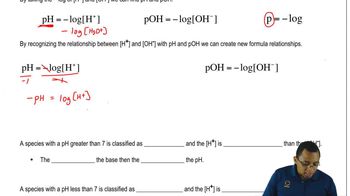Multiple Choice
What is the Kw of pure water at 20.0°C, if the pH is 7.083?
3150
views
6
rank
1
comments
 Verified step by step guidance
Verified step by step guidance Verified video answer for a similar problem:
Verified video answer for a similar problem:



 1:31m
1:31mMaster The pH Scale Concept 1 with a bite sized video explanation from Jules
Start learning